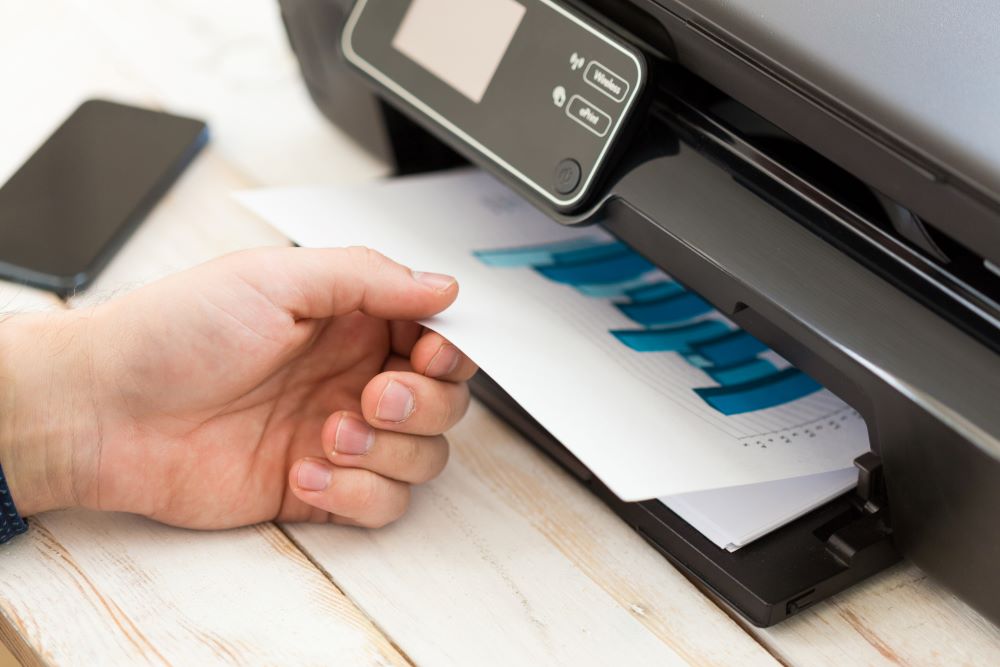Choosing the right business printer may seem daunting, but it doesn’t have to be. There are many models, specifications, and printing technologies to choose from. Ideally, the best printer will serve the specific needs of your business.
Some businesses may prefer only black-and-white printing, while others work with color copies. This article provides you with all the relevant information to make the best choice when selecting a business printer.
Best Business Printer Features
There’s much to consider when buying a new printer for your business. It’s important to first decide what benefits and/or features you require. Printing technology is only one specification of many. Since every business is unique, this will entirely depend upon your type of business.
Some of the key features you want to take into consideration include:
- Printing technology
- Cost (upfront and long-term)
- Performance specifications and functionality (such as DPI, print duty cycle, and speed )
Best Business Printer Technology
The two main printer technologies that businesses use include inkjet printers and laser printers, both with a specialized set of benefits and purposes. Choosing the right one depends on what type of copies you prefer and how frequently your team members will use the printer.
For example, inkjet printers are a great choice if you want to print higher-quality color copies. With better tonal control, inkjet printers blend colors to achieve precise, crisp, and clean hues. They also can adapt to paper types. If your business uses different paper (such as glossy paper) and emphasizes color, an inkjet printer would be right for you.
Inkjet printers are a great choice for designers and photographers. But it’s important to mention that they’re more expensive when it comes to maintenance since you have to replace the ink cartridges. Inkjet printers do have some drawbacks. They can’t print as fast as laser printers and are expensive to maintain. They’re a perfect choice if you don’t frequently print many documents.
That’s where your second option of laser printers comes in. Your business may use a high volume of black-and-white documents. Laser printers are much faster than inkjet printers, allowing you to print more pages per month without wearing out your printer and compromising on quality. They come equipped with high-capacity trays.
Laser printers are the way to go for high-frequency printing. They’re much heavier and bigger than inkjet printers but are suitable choices for offices that prefer to print black-and-white documents daily.
Cost (Upfront & Long-term)
The second consideration is analyzing both upfront and long-term costs. If you have a limited budget, then the upfront cost may be your biggest concern. Inkjet printers tend to be cheaper than laser printers, but costs for consumables such as paper and ink cartridges will accumulate, making the long-term price potentially larger than the initial price.
This will also depend on the specific model you use. Some cartridges are more expensive than others and laser printers need a replacement drum every so often.
The bottom line all depends on your budget and the requirements of your business. Are you comfortable paying a higher upfront cost for a laser printer to minimize the long-term cost of consumables? Or would you perhaps prefer a less costly inkjet printer that requires cartridge replacement?
Your choice will depend on how frequently you need to print documents.
Performance Specifications and Functionality
DPI
There are more specifications to be aware of when choosing the right business printer. For example, the DPI (dots per inch) of a printer indicates printer resolution for detail and precision factors. The higher the DPI of your printer, the more detailed, precise, and sharp the image will be. Some businesses will benefit from owning a printer with a maximal DP, while it may not be a priority for others.
Print Duty Cycle
The print duty cycle refers to the number of pages a printer can handle per month without running into problems with maintenance. This number is an estimate of the maximum number of pages that the printer can print in a month without causing performance issues or reducing its overall lifespan. Most business printers can handle 20,000 pages per month so it’s important to consider this too.
Speed
If you work in a fast-paced business environment, then the printing speed is a big specification to factor in. The higher the PPM or pages per minute, the faster your printer can print documents. With a 14 and higher PPM, laser printers tend to work much faster than inkjet printers at only 3-13 PPM.
A faster business printer may not be your prime concern if you work in a smaller business and don’t need a high volume of daily documents.
Functionality
Business printers can either be single-purpose or multipurpose. Single-purpose printers are designed to complete a single task such as printing documents. They are frequently specialized and have specific features. Multipurpose printers, on the other hand, can handle a variety of tasks, like printing, scanning, copying, and faxing. They are versatile and can handle a wide range of print jobs, but may not offer the same level of quality or speed as a single-purpose printer designed for a specific task.
Multipurpose printers are the right choice if you want a machine that can handle many tasks at once. Alternatively, choose a single purpose printer if value for money is a priority.
The Optimal Printing Solution
There are a lot of factors to take into consideration when choosing the right business printer. It may seem overwhelming in a market filled with different models and features. Golden Gate Office Solutions provides the best technology equipment to businesses in the San Francisco Bay Area. Contact Golden Gate Office Solutions if you’re in need of a reliable and high-quality printing solution for your business.

